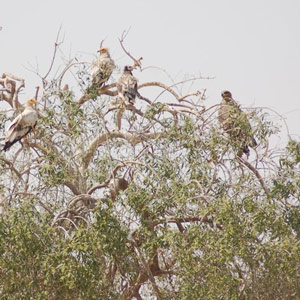Magazine | Voyages
Observer les vautours et les aigles dans la décharge de Jor Beed (Inde)

Percnoptères d’Egypte (Neophron percnopterus) et Aigle des steppes (Aquila nipalensis) sur la décharge de Jor Beed (Rajasthan), hiver 2009-2010.
Photographie : Harsh Vardhan
Introduction
Dans l’édition 2009 de la revue de l’India Bird Fair éditée par la Tourism & Wildlife Society of India (TWSI), un article rédigé par R. N. Mehrotra, responsable de l’office des forêts de l’état du Rajasthan en Inde, évoquait la création sur 5 646 hectares de la Jor Beed Gadwala Bikaner Conservation Reserve, à proximité de la ville de Bikaner. Cette réserve protège notamment la décharge municipale de la ville qui constitue un « hot-spot » pour l’observation des rapaces en hiver: on peut y voir des Percnoptères d’Egypte, Vautours royaux, Vautours de l’Himalaya, Vautours fauves, Vautours moines et parfois Vautours chaugoun et indiens s’affairant autours des carcasses. L’Aigle des steppes, l’Ibis noir, des Corvidés et des mammifères sont aussi attirés.
Mais depuis quelques années le nombre et la diversité de vautours a fortement chuté, à cause principalement de l’ingestion de la chair de cadavres contenant des traces d’un produit vétérinaire, le Diclofenac Sodium désormais interdit en Inde depuis 2006.
Abstract
In the 2009 Issue of the magazine of the India Bird Faire edited by the Tourism & Wildlife Society of India (TWSI), we can read that a new protecte area, the « Jor Beed Gadwala Bikaner Conservation reserve », located on the outskirts of Bikaner city, was established. It is described as a « must see » site for Raptors lovers.
Being a municipal dump, it hosts a great diversity of Vultures in Winter: Egyptian Vulture, Red-headed Vulture, Himalayan Griffon, Eurasian Griffon, Cinereous Vulure and sometimes two elusive species, the White-rumped Vulture and the Long-billed Vulture.
Availability of food also attracts Steppe Eagles, Black Kites, Black Ibis, Indian Rollers, Jackals, …
But the number of Vultures that visit the Bikaner dump has dramatically decreased since a few years. Researches have indicated that this situation is maily due to the consumption of the carcasses of dairy livestock that was treated with an anti-inflammatory drug Diclofenac Sodium, now banned in India.
Poursuivez la lecture de cet article, en vous abonnant dès maintenant !
Découvrez les Archives d’Ornithomedia.com
Pour seulement 10,00 €TTC/an (ou 6,00 € les 6 mois)
Profitez de plusieurs centaines d’articles en accès illimité et sans aucun engagement.
Compléments
À lire sur le web
- Le site web de la TWSI (Tourism Wildlife Society of India) : www.birdfair.org
- Le site web de la Bombay Natural History Society : www.bnhs.org
- La galerie de photos de Warthog : www.panoramio.com/photo/2894673
- La galerie de photos de Tianzhan : www.panoramio.com/user/1003950
Ouvrages recommandés
- Handbook of the Birds of India and Pakistan de Salim Ali (Auteur), Ripley S. Dillon (Auteur)
- Birds of Northern India de Richard Grimmett (Auteur), Tim Inskipp (Auteur)
- Rajasthan Insight Flexi Map
Sources
- R. N. Mehrotra (2009). And now « Conservation Reserves » in Rajasthan. 12th Birding Fair. Pages 8-9
- Orissatv (2009). Rapid decline in vulture population. Date de mise à hour: 2/12. www.orissatv.com/NewsDetail.asp?newsId=NS270
- Mike Pandey (2006). Following their broken wings. Indian Express. www.indianexpress.com/news/following-their-broken-wings/2981/0
- Sivaperuman, Q. H. Baqri, G. Ramaswamy et M. Naseema (2008). Faunal Ecology and Conservation of the Great Indian Desert. Biomedical and Life Sciences. www.springerlink.com/content/g23177nw37544125/
- Anil Kumar Chhangani (2009). Status of vulture population in Rajasthan, India. Indian Forester. Vol: 135. Issue: 2. pp: 239-251
- Press Trust of India (2010). Diclofenac cause for declining vulture population. www.ptinews.com/news/550023_Diclofenac-cause-for-declining-vulture-population




Aucun commentaire sur ce sujet
Participer à la discussion !